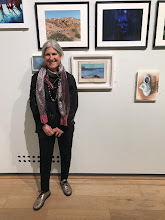skip to main |
skip to sidebar
I wrote my blurb for the NEAC catalogue today and chose an image to send too. Summing up the year was a little tricky, but good. One of the things I thought about and added before I pushed send was something I have realised about me. My process is about discovery. I don't work in a totally premeditated way but it's also not quite the 'not knowing' way I was taught. I realise I paint and draw to understand. So, I might set something up to test but I won't know where the painting and drawing will take me or even what I really want to find out until it's nearly over or maybe even later. It's intuitive but I am discovering and learning as I go and that's why observation has mostly been my starting point. Knowing that feels good!
I continue to read the book I mentioned in the previous post, learning some things I guess I really ought to know… I have been looking at art in galleries, books and museums checking to see if those RULES are hard and fast and the answer is a resounding 'NO'. I went to the Monet at the National on Friday and lo and behold Monet places his subject slap bang in the middle sometimes. His skies might be darker than the ground in some paintings too. Thinking about those things is never a bad thing, though.
Today I wanted to test out one of my nine new canvas covered rabbit skin glue/gesso panels and decided to try to see if I could use the colour yellow in my composition (lots of daffodils at the moment). In general I find yellow and red difficult colours to use together so not quite sure why I did that except the things were nearby and once I'd arranged them they seemed to work. I used the basic palette I was taught to use at Stanford and did not use any black. I loved working on the panel and Louise Balaam's advice to put a final coat of rabbit skin glue over the gesso was brilliant! I will come back to this tomorrow and consider that blue glass vase on the right.
At the start of the week I finally got around to making some supports for egg tempera. It required Patrick to cut MDF into even pieces and me to soak and then warm rabbit skin glue and then add whiting to make gesso. I coated the boards the way Ruth Stage had taught me - about six layers -, sanded them down and planned to take one to my portrait group. The nine prepared boards were going to be for nine portraits. As it turned out, our portrait group was cancelled so I adjusted my previous still life to include a few daffodils and began.
I had forgotten that my previous experience of egg tempera was quite frustrating. It made me even tighter than I can be. That time, I worked from a drawing, which is always hard for me. I decided to think of this experiment as drawing with a brush rather than painting. I don't have tons of pigment. Some of it is from limewashing the walls when Earth and Reed were in Needham Market. Some of it I bought when I was wanting to use lime plaster on wattle and daub as a support, years ago. When I didn't have a colour I needed I took a bit of a broken pastel and crushed it in my mortar and pestle. I had no cadmium yellow, for example. That seems to work. But I should get a good red and a good yellow for the next panel. I discovered that a Q-tip is good at rubbing back to the support white colour. I learned that light on top doesn't seem to work, unless it's naples yellow. I used those pieces of glass from the IKEA frames leftover when I changed to UV glass, as palettes.
I worked pretty randomly, not knowing much and wonder if I went from bigger to smaller, which I kind of did, might result in more variety of strokes. That's what Anthony Williams does. Maybe you could focus the eye differently that way.
I began in the morning yesterday and then painted again last night - even though the light was totally different, finishing it off in today's light. Probably because of the colours and the brushstrokes (to me) it evokes Gaugin, or one of the Bloomsbury bunch. It's fascinating the way materials change the way you see, work and express yourself.






